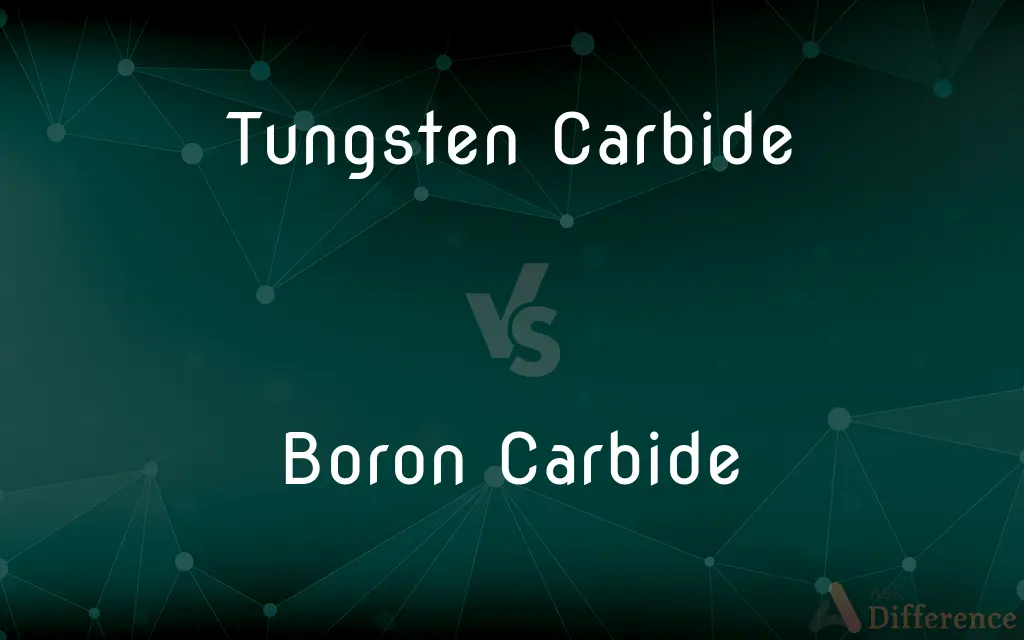Tungsten Carbide vs. Boron Carbide — What's the Difference?
By Tayyaba Rehman — Published on November 19, 2023
Tungsten Carbide (WC) is a hard material used in machining tools. Boron Carbide (B₄C) is a hard compound used in armor and abrasives. Both differ in composition and applications.

Difference Between Tungsten Carbide and Boron Carbide
Table of Contents
ADVERTISEMENT
Key Differences
Tungsten Carbide and Boron Carbide are both incredibly hard materials, but they hail from different elemental backgrounds and have distinct applications. Dive into their specifics, and the contrasts become evident.
Tungsten Carbide, often denoted as WC, is a chemical compound containing equal parts of tungsten and carbon atoms. In its raw form, it's a fine powder, but when pressed and sintered, it becomes extremely hard, rivaling diamonds. This hardness makes Tungsten Carbide invaluable in the manufacture of industrial machinery and cutting tools. On the contrary, Boron Carbide, represented as B₄C, is one of the hardest materials on earth, coming third after diamond and cubic boron nitride.
While Tungsten Carbide's primary claim to fame is its use in cutting, drilling, and mining tools due to its sturdiness and resistance to wear, Boron Carbide takes a different route. B₄C's unique attributes make it ideal for body armor, bulletproof vests, and even tank armor. This is because, besides being hard, it's also relatively lightweight.
Another noteworthy application of Boron Carbide is in nuclear reactors. Its ability to absorb neutrons makes it useful for this purpose. Conversely, Tungsten Carbide is frequently used in jewelry, particularly in men's wedding bands, as it's resistant to scratching.
Comparison Chart
Chemical Formula
WC
B₄C
ADVERTISEMENT
Primary Use
Industrial machinery and cutting tools
Body armor, abrasives, and neutron absorber
Rank in Hardness
Below B₄C but above many materials
Third hardest material after diamond
Weight
Heavier
Relatively lightweight
Presence in Jewelry
Common in men's wedding bands
Rarely used
Compare with Definitions
Tungsten Carbide
A compound of tungsten and carbon.
The drill bit made of Tungsten Carbide easily pierced the tough material.
Boron Carbide
Used in abrasive applications.
The Boron Carbide abrasive ensured a smooth finish on the metal surface.
Tungsten Carbide
Resistant to scratches and wear.
His Tungsten Carbide wedding band looked as new as the day he bought it.
Boron Carbide
One of the hardest materials on Earth.
Only a few materials, like diamond, surpass Boron Carbide in hardness.
Tungsten Carbide
Known for its extreme hardness.
Tungsten Carbide tools retain their sharpness for a long time.
Boron Carbide
Composed of boron and carbon elements.
Research on Boron Carbide has revealed potential uses in futuristic technologies.
Tungsten Carbide
Common in jewelry and machinery.
Due to its durability, Tungsten Carbide is a favorite among engineers and jewelers alike.
Boron Carbide
A superhard material used in armor.
The tank was reinforced with Boron Carbide for added protection.
Tungsten Carbide
Used in industrial cutting and drilling.
The factory replaced all their old tools with Tungsten Carbide variants for better efficiency.
Boron Carbide
Known as a neutron absorber in nuclear reactors.
Boron Carbide rods help control the nuclear reaction.
Common Curiosities
Is Boron Carbide harder than Tungsten Carbide?
Yes, Boron Carbide is one of the few materials harder than Tungsten Carbide.
Can I find Tungsten Carbide in jewelry?
Yes, Tungsten Carbide is popular in jewelry, especially men's wedding bands.
Why is Boron Carbide used in body armor?
Boron Carbide is extremely hard yet lightweight, making it ideal for protective gear.
Is Tungsten Carbide resistant to wear and tear?
Yes, Tungsten Carbide is renowned for its resistance to wear, which is why it's used in tools and machinery.
What is Tungsten Carbide commonly used for?
Tungsten Carbide is primarily used for making industrial machinery and cutting tools.
How is Tungsten Carbide formed?
Tungsten Carbide is formed by combining tungsten and carbon at high temperatures.
Are there any risks associated with Tungsten Carbide?
Tungsten Carbide is generally safe, but inhaling its dust during manufacturing can be harmful.
Is Boron Carbide naturally occurring?
While boron and carbon are naturally occurring, Boron Carbide is synthesized from these elements.
Is Boron Carbide used in any everyday items?
While not common in daily items, Boron Carbide is found in abrasives and some high-performance equipment.
How does Boron Carbide function in nuclear reactors?
Boron Carbide acts as a neutron absorber, controlling the nuclear reaction.
Can Boron Carbide be used as a gemstone?
While extremely hard, Boron Carbide is not typically used as a gemstone due to its dark color and lack of brilliance.
Can Tungsten Carbide be melted?
Tungsten Carbide has a high melting point but can be melted under specific conditions.
What color is Tungsten Carbide?
Tungsten Carbide is generally a gray or silver-gray metallic color.
How does Tungsten Carbide compare to diamond in terms of hardness?
While Tungsten Carbide is extremely hard, diamond is still harder.
What makes Boron Carbide unique in its category?
Boron Carbide stands out due to its combination of extreme hardness and light weight.
Share Your Discovery

Previous Comparison
Net Calorific Value vs. Gross Calorific Value
Next Comparison
Electric Field vs. Magnetic FieldAuthor Spotlight
Written by
Tayyaba RehmanTayyaba Rehman is a distinguished writer, currently serving as a primary contributor to askdifference.com. As a researcher in semantics and etymology, Tayyaba's passion for the complexity of languages and their distinctions has found a perfect home on the platform. Tayyaba delves into the intricacies of language, distinguishing between commonly confused words and phrases, thereby providing clarity for readers worldwide.
















































